1954-1971
Written by the MIdwest Rail Rangers
E-mail: info@railrangers.org
This article is (c)2019 Midwest Rail Rangers Corporation. Note: Amtrak, Pacific Parlour Car, and Coast Starlight are all trademarks of the National Railroad Passenger Corporation. This website is operated for information purposes only and has no affiliation with Amtrak, The Coast Starlight, Budd Company, or any other organization besides the Midwest Rail Rangers.
The story behind what would become Amtrak's Pacific Parlour Cars begins in 1950. This is when the Chicago, Burlington & Quincy Railroad received its first bi-level commuter coaches that ran between Downtown Chicago, the western suburbs, and Aurora. The CB&Q was able to get more passengers on a car by having two levels of seating, instead of one... something that was really not done until this point. (Note: The one exception might be the prototype dome car the CB&Q had built in 1945).
The CB&Q's then-rival... the Atchison, Topeka, and the Santa Fe Railway... decided to try this new bi-level design for long-distance purposes. In 1952, the Santa Fe placed a rather sizable order of Hi-Level equipment with the Budd Company. This included around 40 coaches, plus six dining cars and six lounge cars. All were built between 1954 and early 1956. These cars were needed for daily use on the all-coach El Capitan between Chicago and Los Angeles (Trains #21 & #22). The Hi-Levels stood 15.5 feet high, two feet taller than most conventional equipment. Each Hi-Level car cost about $275,000 to build back in the day (that would be equivalent to about $2.63 million in today's money).
In the Hi-Level coaches, seating occupied the entire upper level, with restrooms, baggage, and other non-revenue areas on the lower level. In most cars, vestibules connected the upper levels only. A central staircase linked the two levels. Hi-Levels featured a row of windows across the upper level; on the prototype coaches, this row slanted inwards.The two-level design offered advantages over conventional single-level equipment. Budd and the Santa Fe expected the upper level, located more than eight feet above the rails, to provide a smoother, quieter ride for passengers. The lower level of every car free of passengers, allowing designers to include larger restrooms and baggage areas. The lower level also contained all the electrical equipment, away from the passengers, and with easy access for maintenance workers when repairs were needed en route.
While the Hi-Level coaches and dining cars also have their own very unique stories... we will focus our writings and historical photo collection here on PacificParlourCar.com almost entirely on the six Hi-Level Lounge Cars... since these would later go on to become Amtrak's Pacific Parlour Cars.
Let's learn more about these historic rail cars by taking a look at some of the early advertisements when the Hi-Level cars were introduced in the mid-1950's by the Atchison, Topeka, and the Santa Fe:
In the above post card, you may have noticed the number of the car by the side of the door - #578. The Hi-Level lounges were not given a name by Budd or the Santa Fe when they were built. They were just Hi-Level lounge cars numbered #575, #576, #577, #578. #579, and #580. Part of the reason for this might have been the fact that car names were generally reserved for those pieces of equipment serving the more luxurious Super Chief. The El Capitan did not get quite as much publicity or prestige being an all-coach train.
Lounge Car #577 (which has been owned by the Wisconsin Great Northern since 2019) was used on the Santa Fe's Hi-Level Exhibition Train that toured the system in June and early July 1956 to introduce the new El Capitan equipment to news reporters and prospective riders. A formal "christening" of the car took place in Albuquerque, New Mexico on July 8, 1956, with Beltran Alfonso Osorio, the 18th duke of Albuquerque in attendance. Regular revenue service began a week later -- July 15, 1956.
As originally configured, each Hi-Level lounge car could seat a total of 60 passengers on the upper level; that included a mix of single seats and two-and four-top tables. There was also a news stand on the upper level. Nicknames for these cars used in Santa Fe promotional material included "Top of the Cap" and "Sky Lounges". A partial glass top distinguished the Hi-Level lounges from the Hi-Level dining cars and coaches used on the El Capitan. The lower level featured the Kachina Coffee Shop and a lounge area with seating for 26 passengers. During the original years of operation under the Santa Fe, attendants staffed both levels of the car.
Just 18 months after the Hi-Level lounge cars were put into regular service on the El Capitan, the Santa Fe decided to combine the all-coach train with its flagship all-Pullman sleeping car Super Chief during off-peak travel periods. While the train retained both names, it operated on the same schedule as one set of equipment during winter months between Chicago and Los Angeles starting in January 1958.
Two years later, passenger ridership continued to substantially decline so much that railroad officials combined the El Capitan and Super Chief on a year-round basis. A typical consist in the late 1960's would include two locomotives, two baggage cars, a baggage-dormitory transition car, two Hi-Level coach cars, a Hi-Level dining car, a Hi-Level lounge car, two more Hi-Level coach cars, two sleeping cars, a Pleasure Dome, a Fred Harvey Company Diner, and two more sleeping cars. As such, the Hi-Level lounge cars would have been located towards the middle of the train's consist.
Despite the obvious cut-backs, the El Capitan and Super Chief retained separate dining and lounge cars through the final days of the Santa Fe's passenger train service.
Let's take a look at some more promotional pieces featuring the Hi-Level lounge cars from the late 1950's and early 1960's:
The last day the Hi-Level lounges operated under Santa Fe service was Friday, April 30, 1971. The following day Amtrak took over operations of the cars -- and most long-distance passenger rail in the United States. The story about the Hi-Level cars continues when you click "Amtrak Lounge Years" link on the left side.
PacificParlourCar.com was founded by Anton Lazzaro and is currently maintained by the Midwest Rail Rangers. If you enjoyed the content, please consider making a donation to our 501(c)(3) non-profit organization. Click the link below; even the smallest amounts help our research, web design, and domain hosting. You can also get in touch with us by e-mailing our Board of Directors: board@railrangers.org.



An original blue print from when the Santa Fe Hi-Level lounge cars were built by Budd in the mid-1950's. Only six Hi-Level lounge cars were ever built.
An original blue print from when the Santa Fe Hi-Level coach cars were built by Budd in the mid-1950's. A total of 61 Hi-Level coaches were built.
An original blue print from when the Santa Fe Hi-Level dining cars were built by Budd in the mid-1950's. Only six Hi-Level dining cars were ever built.

The Santa Fe Hi-Level lounge car is one of the cars featured here in a 1950's Santa Fe advertisement.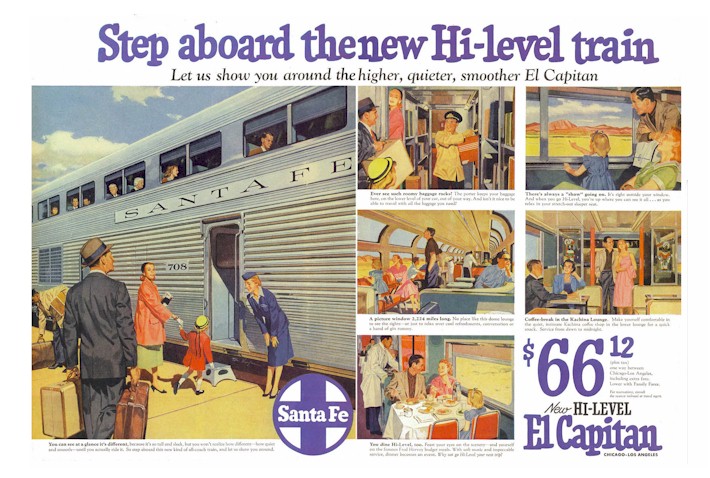
A Santa Fe Railroad advertisement for the El Capitan, shortly after the new Hi-Level equipment was released.
A Native American looks on as the new Santa Fe Hi-Level lounge car rolls in and lets passengers off the train.
Here is a copy of the above ad, as seen in full, with a Native American looking in awe at the new equipment as passengers get off the train.
A late 1950's add for the El Capitan features the Hi-Level lounge car --- and a mom, a Santa Fe courier nurse, and a child.
A late 1950's add for the El Capitan features the Hi-Level lounge car --- including a man buying pottery from a Native American on the platform at Albuquerque.
A late 1950's add for the El Capitan features the Hi-Level lounge car --- touting the Hi-Levels as being more quiet and comfortable than single-level train equipment.
The Santa Fe Hi-Level "Sky Lounge" is a great way to travel!
Even though this was a small part of the ad, we were able to enlarge it - so you can get a good view of the original interior of the Hi-Level lounge cars. This is a view of what the upper level of the cars once looked like before undergoing several refurbishments.
While the upper level of the Hi-Level lounges were excellent for sightseeing, those who wanted a coffee fitx could head down to the Kachina Lounge on the lower level of the car. As the ad says, "Make yourself comfortable in the quite, intimate Kachina coffee shop in the lower lounge..."
This Budd advertisement shows the variety of equipment that is could produce - including the Santa Fe Hi-Level lounges, pictured at the bottom.
Another early advertisement for the Santa Fe highlights the new Hi-Level lounge car.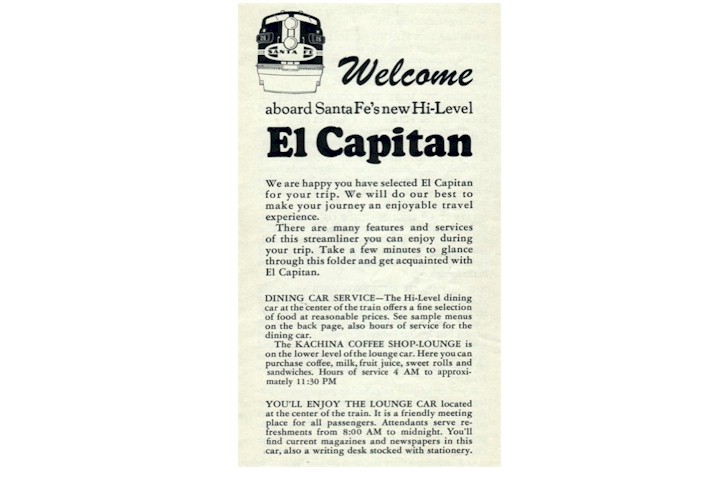
Above is another early advertisement from the 1950's, promoting the new Hi-Level lounge car with the Kachina Coffee Shop-Lounge below.
Above is another early advertisement from the 1950's, promoting the new Hi-Level lounge car with the Kachina Coffee Shop-Lounge below.
Here is a luggage tag that you might have received in the 1950's if you were traveling on the El Capitan with the new Hi-Level equipment!
This is an image of the Santa Fe's Kachina - it was used by the railroad for many purposes.
The Santa Fe Hi-Level lounge car can clearly be made out in this photo of the El Capitan at a stop in Southern California.
This black and white photo is one of the earliest photos that we could find from the 1950's of people enjoying the new Hi-Level lounge cars.
Here is another photo of people in a quite crowded Santa Fe Hi-Level lounge car from the late 1950's or early 1960's; notice the nun!
(PHOTO COURTESY: John H. White, Jr.)
The double decker Hi-Level equipment on the El Capitan rounds a curve.
This excellent photograph shows off what the Santa Fe Hi-Level lounge cars looked like soon after their 1956 release.
This photo was turned into a post card by the Santa Fe and were given out to passengers for promotional purposes on the El Capitan. This is possibly one of the most famous and well-used photos featuring a Santa Fe Hi-Level lounge car.

A view of the combined Super Chief and El Capitan trains, featuring Hi-Level and single-level equipment.
A color photo of several Santa Fe engines and the Hi-Level equipment behind them.
A color photo of several Santa Fe engines and the Hi-Level equipment behind them at Los Angeles Union Station.
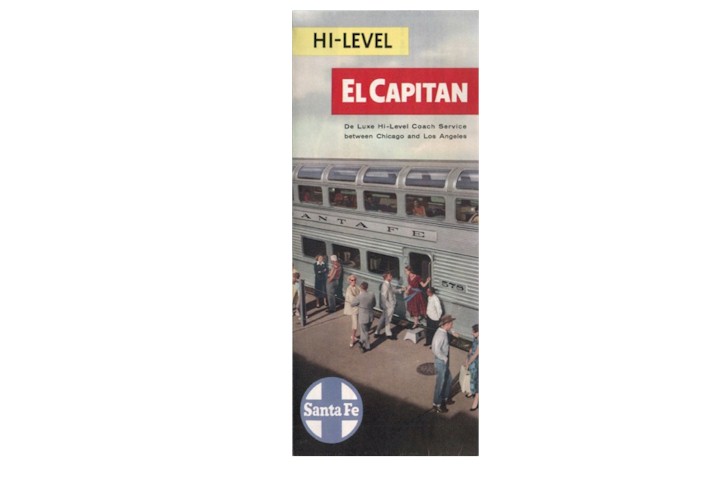
The same image used for the post card posted earlier was used for this Santa Fe promotional brochure.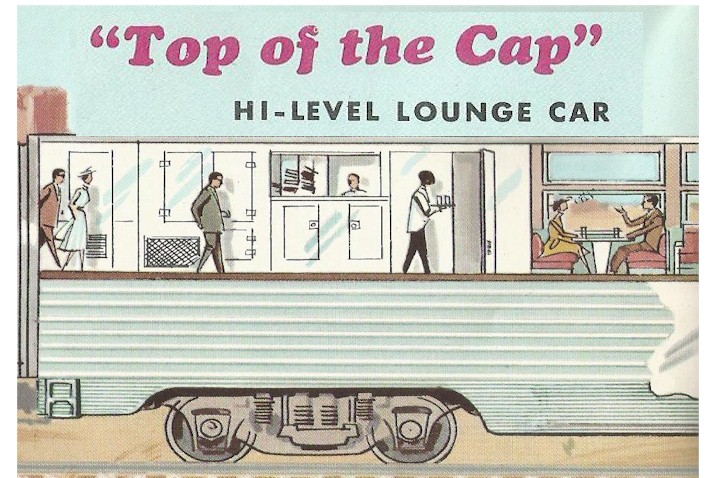
A brochure showing a side-view of the Santa Fe Hi-Level lounge car - now known more commonly as the "Top of the Cap" car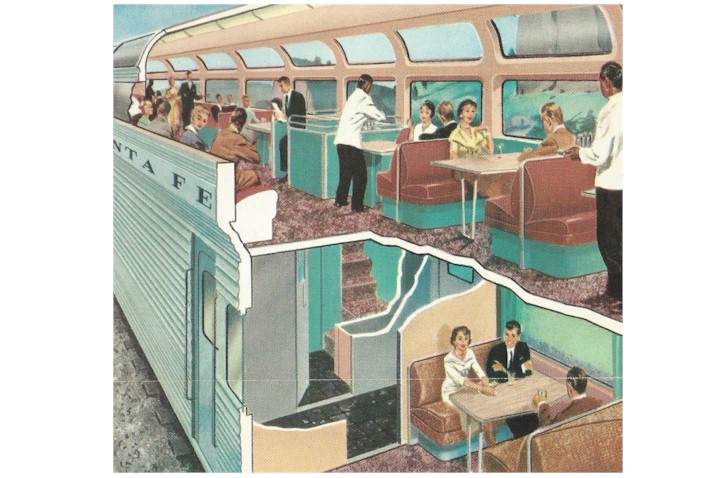
A diagram showing the upper and lower level of the Hi-Level lounge cars.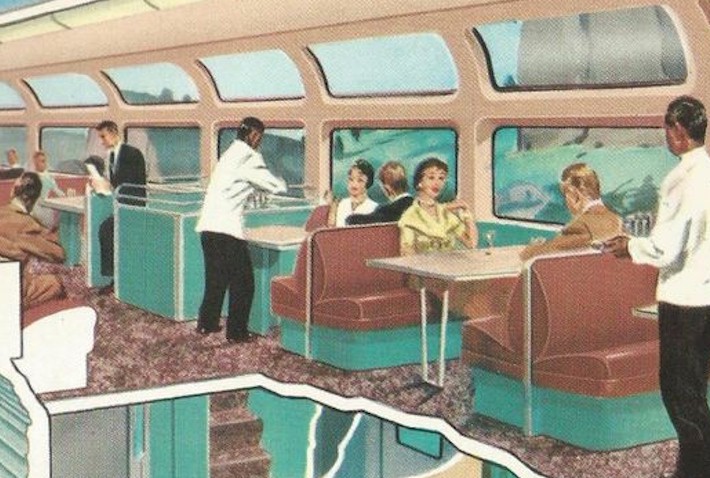
Above is another early advertisement from the 1950's, promoting the new Hi-Level lounge car with the Kachina Coffee Shop-Lounge below.
The same diagram - zoomed in on the lower level of the Hi-Level lounge car; this is part of the Kachina Coffee Shop area.
This 3-D model shows what the Santa Fe Kachina Coffee Shop looked like on the lower level of the Hi-Level lounge cars.
A typical check that a passenger would receive after dining in the Kachina Coffee Shop. Notice the various food and drink selections and the prices.
A Santa Fe promotional photo of the upper level of the Hi-Level lounge car.
We move now into the 1960's; this is one of the first colored photos of the interior of the Santa Fe Hi-Level lounge car. It is still in its original configuration here; note the Kachina symbols on both sides of the wall in the distance.
A Santa Fe courier nurse was usually part of the staff of the El Capitan; here a courier nurse is pictured outside a Hi-Level coach car.
A photo of the Hi-Level lounge car in 1970, during its last full year of service on the Santa Fe.

A model railroad version of the Santa Fe Hi-Level lounge car is a great addition to one's model railroad collection.
A model railroad version of the Santa Fe Hi-Level lounge car is a great addition to one's model railroad collection.
A model railroad version of the Santa Fe Hi-Level lounge car is a great addition to one's model railroad collection.
A model railroad version of the Santa Fe Hi-Level lounge car is a great addition to one's model railroad collection.


